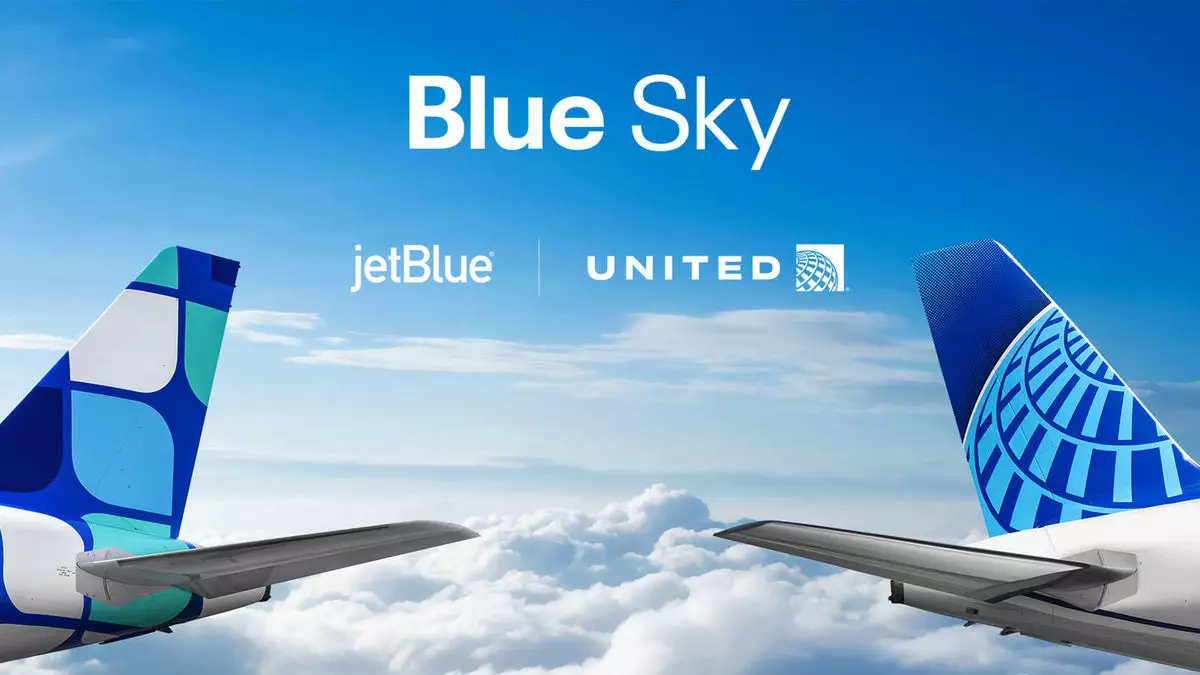The recent partnership between United Airlines and JetBlue, publicized on May 29, has introduced a transformative dynamic in the aviation sector, particularly in the competitive landscapes of New York and the Northeast. This collaboration, dubbed “Blue Sky,” seeks to enhance the customer experience of both airlines’ loyalty programs by allowing members to accrue and redeem points across their networks. However, while initial reports suggest potential consumer benefits, a deeper exploration reveals a more nuanced impact on airline competition and market landscapes, raising questions about the true beneficiaries of this alliance.
Loyalty Programs: A Double-Edged Sword
The partnership promises mutual benefits for loyalty program members, with JetBlue’s TrueBlue and United’s Mileage Plus programs allowing reciprocal status privileges and access to a more extensive network. This expanded reach is undoubtedly appealing—who wouldn’t appreciate the ability to earn and redeem points across a broader selection of destinations? TrueBlue members stand to gain access to United’s global network, which boasts over 200 destinations, including locations that JetBlue does not serve. Conversely, Mileage Plus members will find significant value in JetBlue’s roster, particularly in the Northeast-Caribbean routes.
Despite these advantages, the structure of the partnership raises concerns about market competition. Airline industry analyst Gary Leff has positioned the deal as a boon for United, suggesting it effectively fortifies the airline’s dominance in the New York metro area. By absorbing JetBlue’s slots at JFK, United reclaims a strategic position it vacated in 2015, which could inadvertently stifle competition in the region instead of fostering a more balanced environment among carriers. The limited nature of their cooperation, eschewing codesharing in favor of an interline agreement, suggests that this alliance may not be as revolutionary for consumer choice as it initially appears.
A Shift in Competitive Dynamics
The implications for competition unfold further when we consider the broader motivations behind the United-JetBlue deal. The failure of JetBlue’s prior Northeast Alliance with American Airlines, dismissed due to concerns over anti-competitive practices, serves as a backdrop for the current arrangement. Although the partnership does heed regulatory caution by avoiding aggressive revenue-sharing entities and joint scheduling, it simultaneously positions United as an even more formidable adversary against regional competitors like American and, to a lesser extent, Delta.
As the landscape reshapes, the expected outcomes for different players vary significantly. While United strengthens its foothold and JetBlue gains certain operational advantages at Newark, the balance of power could shift unfavorably for consumers if competition is further diminished. Leff’s analysis implies that as JetBlue pulls back from forming alliances with other significant players, the overall consumer experience in the Northeast could degrade due to lack of genuine choice.
JetBlue’s Potential: The Silver Lining
Despite the concerns for competition, the collaboration isn’t devoid of merit for JetBlue. By enhancing its connectivity to a wider span of destinations, JetBlue’s TrueBlue members may experience substantial rewards. For those holding Mosaic status, recombining the offerings of both airlines could enhance travel prospects, making the program even more enticing.
Brett Snyder, another industry analyst, asserts that JetBlue stands to bolster its competitive edge against American Airlines, providing tools that could allow it to better capture market share against its rivals. JetBlue’s operational expansion at Newark and opportunities for addition travel routes present a rare silver lining amidst a shifting competitive landscape, potentially benefiting its dedicated customer base.
Consumer Impact: A Complex Terrain
Ultimately, the implications for consumers blur lines—while the partnership seeks to provide enhanced loyalty benefits, the overarching dynamics suggest a subtle reduction in competition. With United solidifying its success by acquiring advantageous JFK slots, the potential for varied service options across airlines may dwindle, particularly for customers navigating the skies above New York and Boston.
The partnership creates a more complex landscape where increased consumer advantages are juxtaposed against a potential decline in competitive diversity. While some travel routes become more accessible, consumers may soon find themselves in a market dominated by fewer players, where choices are limited and fare flexibility becomes more restrictive. The agreement has indeed set the stage for an era of closer collaboration between United and JetBlue; however, the consequences attached to that collaboration raise profound questions about its ultimate benefit to air travelers.
In a world where the conversation around competition remains ever-essential for the consumer, the United-JetBlue partnership reflects a pivotal moment in aviation, beckoning a cautious optimism that might yet prove elusive in the face of evolving market dynamics.


Leave a Reply